Lessico
Priapo
Priapismo
Priapismo roccioso ![]()
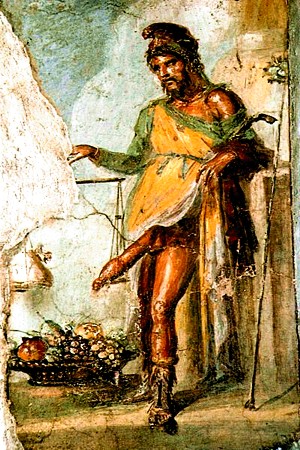
Il dio
romano Mercurio![]() , dio del commercio e dell'abbondanza, fuso con il dio romano
della fecondità e dell'abbondanza, Priapo. Affresco dalla Casa dei Vettii,
Pompei.
, dio del commercio e dell'abbondanza, fuso con il dio romano
della fecondità e dell'abbondanza, Priapo. Affresco dalla Casa dei Vettii,
Pompei.
Priapo è
un personaggio della mitologia greca e romana, figlio di Dioniso![]() e di
Afrodite
e di
Afrodite![]() . Altri lo ritengono nato dall'unione della dea con
Ermes
. Altri lo ritengono nato dall'unione della dea con
Ermes![]() , con Ares
, con Ares![]() ,
con Adone
,
con Adone![]() o con lo stesso
Zeus
o con lo stesso
Zeus![]() . Era
. Era![]() gli diede un orrendo aspetto, con
enormi genitali. Lo si può considerare una personificazione del fallo (era
rappresentato come una figura itifallica, cioè col pene eretto, in quanto il
greco ithýphallos è composto da ithýs = dritto e phallós
= fallo) e del connesso simbolismo che andava dalla fecondità a una generica
funzione apotropaica (capace di allontanare in modo specifico il malocchio).
gli diede un orrendo aspetto, con
enormi genitali. Lo si può considerare una personificazione del fallo (era
rappresentato come una figura itifallica, cioè col pene eretto, in quanto il
greco ithýphallos è composto da ithýs = dritto e phallós
= fallo) e del connesso simbolismo che andava dalla fecondità a una generica
funzione apotropaica (capace di allontanare in modo specifico il malocchio).
Priapo, che si vuole proveniente dall'Ellesponto o dalla Propontide, dominava l'istinto, la forza sessuale maschile e la fertilità della natura. Non fu accettato fra gli dèi olimpici poiché tentò, ubriaco, di abusare di Estia, personificazione divina del focolare, da cui trae il nome (hestía in greco). Anche l'asino, simbolo di lussuria, gli ragliò contro per farlo scappare, così da sottolineare quale intento criminoso avesse.
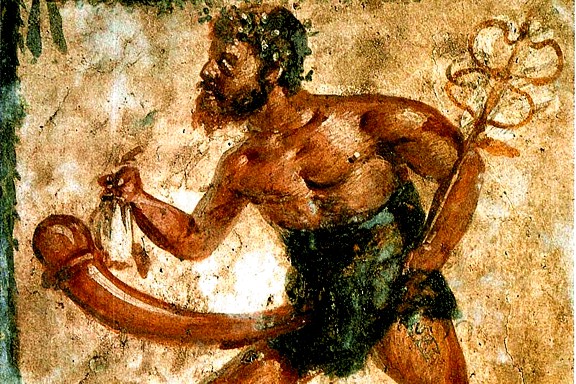
Figura portafortuna che fonde gli attribuiti di due divinità dell'abbondanza: Priapo (riconoscibile dall'enorme fallo in erezione), dio della fecondità, e Mercurio, dio del commercio, riconoscibile dal caduceo. Affresco da Pompei databile dall'89 aC al 79 dC. – Napoli, Museo Archeologico Nazionale.
Il culto di Priapo risale ai tempi di Alessandro Magno![]() e fu ripreso anche
dai Romani, soprattutto collegato ai riti e alle orge dionisiache. Il suo
culto era anche associato alla protezione delle greggi, dei pesci, delle api,
degli orti. Il suo animale era l'asino
e fu ripreso anche
dai Romani, soprattutto collegato ai riti e alle orge dionisiache. Il suo
culto era anche associato alla protezione delle greggi, dei pesci, delle api,
degli orti. Il suo animale era l'asino![]() , sia a causa dell'importanza che esso
aveva nella vita contadina, sia per una sorta di analogia fra i membri di
Priapo e dell'asino.
, sia a causa dell'importanza che esso
aveva nella vita contadina, sia per una sorta di analogia fra i membri di
Priapo e dell'asino.
Ogni anno a Priapo veniva sacrificato un asino: questo rito venne istituito dallo stesso Priapo. Il dio stava insidiando la ninfa Lotide dormiente, ma il ragliare di un asino svegliò la ninfa impedendo al dio il suo intento. A espiazione dell'accaduto il dio pretese un sacrificio annuale di un asino.
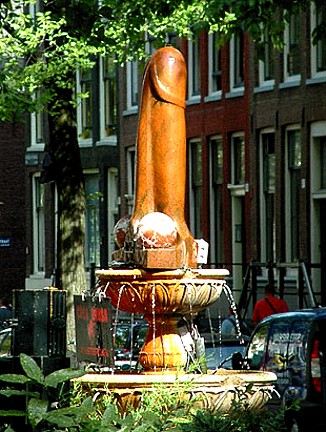
Amsterdam - Quartiere a luci rosse
Priapismo
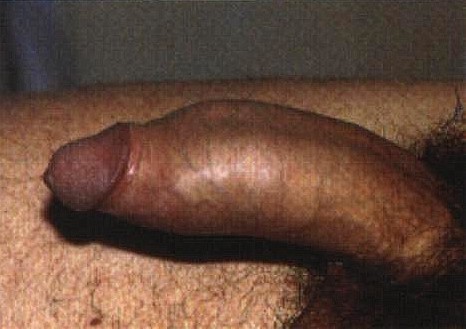
Il priapismo è un'erezione persistente e anomala (di durata superiore a 4 ore) e spesso dolorosa dei soli corpi cavernosi del pene, non accompagnata da desiderio sessuale o eccitazione. L'erezione, che non riguarda l'uretra spongiosa né il glande, è spesso dolorosa e può rappresentare un'urgenza chirurgica che va trattata non oltre 6-8 ore dalla sua insorgenza, poiché si potrebbe verificare una scarsa ossigenazione dei tessuti che degenererebbe nella perdita della funzione erettile.
Esistono due tipologie di priapismo, uno a basso flusso (o priapismo venoso) e uno ad alto flusso (o priapismo arterioso). Il primo caso è dovuto ad affezioni organiche quali leucemia, anemia falciforme, lesioni midollari o neurologiche, infiltrazioni tumorali, abuso di psicofarmaci, abitudine all'assunzione di sostanze stupefacenti o essere dovuto a una errata terapia contro la disfunzione erettile. Nel secondo caso la causa è di solito di natura traumatica da rottura di una arteria cavernosa (una delle arterie che permettono la normale erezione che si trovano all'interno dei corpi cavernosi del pene). Quest'ultimo caso spesso non necessita di interventi in urgenza mentre il priapismo di tipo venoso è sempre un'urgenza urologica.
Il termine è talora impiegato in modo più generico come sinonimo di
satiriasi![]() . Priapismo deriva da quello della divinità greca Priapo, spesso
rappresentato con un fallo di proporzioni esagerate. Opposta al priapismo
(figurativamente e non in termini medici) è la disfunzione erettile o
impotenza.
. Priapismo deriva da quello della divinità greca Priapo, spesso
rappresentato con un fallo di proporzioni esagerate. Opposta al priapismo
(figurativamente e non in termini medici) è la disfunzione erettile o
impotenza.
Fungus Priapeius
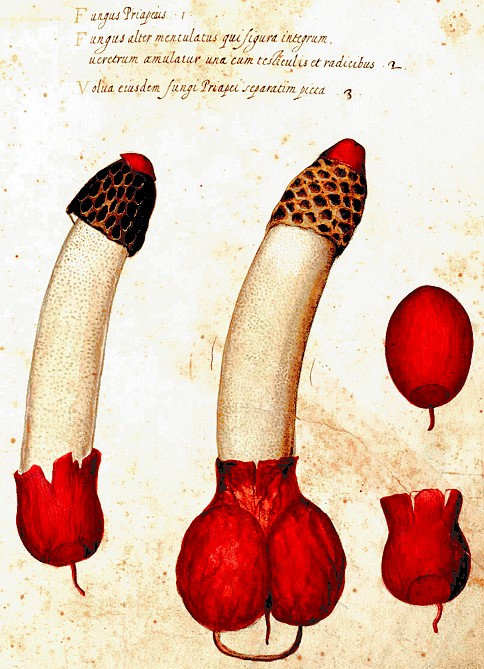
Acquarello![]() di Ulisse Aldrovandi
di Ulisse Aldrovandi
l'odierno Phallus hadriani
in memoria di Adriaen de Jonghe o Hadrianus Junius![]()
Il Phallus
impudicus - detto Satirione![]() - o Ithyphallus impudicus (ithyphallus
= fallo dritto) ha l'involucro volviforme di colore biancastro, mentre quello
del Phallus hadriani è rosato porporino.
- o Ithyphallus impudicus (ithyphallus
= fallo dritto) ha l'involucro volviforme di colore biancastro, mentre quello
del Phallus hadriani è rosato porporino.

Untitled, nicknamed "Priapus with Caduceus", "Priapus-Mercury", or erroneously "Well-endowed Mercury": a character with the beard and giant erect phallus of Priapus is walking away with the caduceus and winged sandals of Mercury (supposedly, the humour was to see Priapus thieving the god of thieves, but both are gods of fertility and abundance). Anonymous fresco in Pompeii, between 89 BC and 79 AD. Museo Archeologico Nazionale (Naples), Italia.
In Greek mythology, Priapus (Ancient Greek: Príapos) was a minor rustic fertility god, protector of livestock, fruit plants, gardens and male genitalia. His Roman equivalent was Mutinus Mutunus. He was best noted for his huge, permanently erect penis, which gave rise to the medical term priapism.
He was described as the son of Aphrodite by Dionysus, Hermes, Zeus or Pan, depending on the source. According to legend, Hera cursed him with impotence, ugliness and foul-mindedness while he was still in Aphrodite's womb, in revenge for the hero Paris having the temerity to judge Aphrodite more beautiful than Hera. The other gods refused to allow him to live on Mount Olympus and threw him down to Earth, where he was brought up by shepherds.
Priapus joined Pan and the satyrs as a spirit of fertility and growth, though he was perennially frustrated by his impotence. He attempted to rape the nymph Lotis but was thwarted by an ass, whose braying caused him to lose his erection at the critical moment and woke Lotis. He pursued the nymph until the gods took pity on her and turned her into a lotus plant. The episode gave him a lasting hatred of asses and a willingness to see them killed in his honour. In the end, his lust gave him a permanent erection and his penis grew so large that he was unable to move.
The first extant mention of Priapus is in the eponymous comedy Priapus, written in the fourth century BC by Xenarchus. Originally worshipped by Greek colonists in Lampsacus in Asia Minor, the cult of Priapus spread to mainland Greece and eventually to Italy during the third century BC. Lucian (De saltatione) tells that in Bithynia Priapus was accounted as a warlike god, a rustic tutor to the infant Ares. Arnobius is aware of the importance accorded Priapus in this region near the Hellespont. Also, Pausanias notes:
"This god is worshipped where goats and sheep pasture or there are swarms of bees; but by the people of Lampsacus he is more revered than any other god, being called by them a son of Dionysus and Aphrodite." (Description of Greece IX.312)
Outside his "home" region in Asia Minor, Priapus was regarded as something of a joke by urban dwellers. However, he played a more important role in the countryside, where he was seen as a guardian deity. He was regarded as the patron god of sailors and fishermen and others in need of good luck, and his presence was believed to avert the evil eye.
Priapus does not appear to have had an organised cult and was mostly worshipped in gardens or homes, though there are attestations of temples dedicated to the god. His sacrificial animal was the ass, reflecting his lustful nature, but agricultural offerings (such as fruit, flowers, vegetables and fish) were also very common.
Long after the fall of Rome and the rise of Christianity, Priapus continued to be invoked as a symbol of health and fertility. The 13th century Lanercost Chronicle, a history of northern England and Scotland, records a "lay Cistercian brother" erecting a statue of Priapus (simulacrum Priapi statuere) in a bid to end an outbreak of cattle disease. In the 1980s, D. F. Cassidy founded the St. Priapus Church as a modern church centred on worship of the phallus.
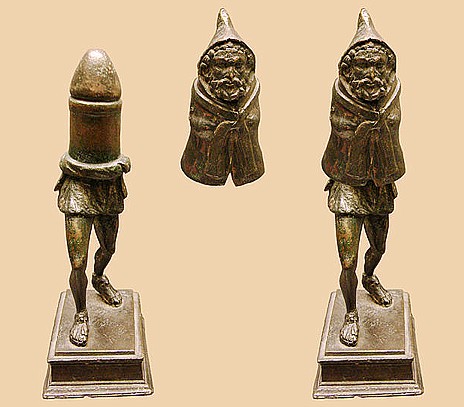
Roman statuette of Priapus discovered in France. Bronze statuette of the Roman fertility god Priapus, made in two parts (shown here in assembled and disassembled forms). This statuette has been dated to the late 1st century CE. It was found in Rivery, in Picardy, France in 1771 and is the oldest Gallo-Roman object in the collection of the Museum of Picardy. This figurine represents the deity clothed in a "cuculus", a Gallic coat with hood. This upper section is detachable and conceals a phallus.
Priapus' iconic attribute was his ithyphallicism (permanently erect penis); he probably absorbed some pre-existing ithyphallic deities as his cult developed. He was represented in a variety of ways, most commonly as a misshapen gnome-like figure with an enormous erect phallus. Statues of Priapus were common in ancient Greece and Rome, standing in gardens or at doorways and crossroads. To propitiate Priapus, the traveller would stroke the statue's penis as he passed by. The Athenians often conflated Priapus with Hermes, the god of boundaries, and depicted a hybrid deity with a winged helmet, sandals and huge erection. Statues of Priapus were often hung with signs bearing epigrams, collected in Priapeia (treated below), which threatened sexual assault towards transgressors of the boundaries that he protected:
Percidere, puer, moneo; futuere, puella;
barbatum furem tertia poena manet.
Femina si furtum faciet mihi virve puerve,
haec cunnum, caput hic praebeat, ille nates.
Per medios ibit pueros mediasque puellas
mentula, barbatis non nisi summa petet.
I warn you, boy, you will be sodomised; girl, you will be fucked; a third
penalty awaits the bearded thief.
If a woman steals from me, or a man, or a boy, let the first give me her cunt,
the second his head, the third his buttocks.
My instrument of forceful lust will go through the middle of boys and the
middle of girls, but with bearded men it will aim only for the top.

Fresco of Priapus, Casa dei Vettii, Pompeii. Depicted weighing his large erect penis against a bag of gold. Unlike the Greeks, Ancient Romans admired the large penis of Priapus, although they had a sense of humor about it.
A number of Roman paintings of Priapus have survived from ancient times. One of the most famous such images of Priapus is that from the House of the Vettii in Pompeii. A fresco depicts the god weighing his phallus against a bag full of money; it appears that his phallus is heavier. In nearby Herculaneum, an excavated snack bar has a painting of Priapus behind the bar, apparently as a good-luck symbol for the customers.
Priapus gave rise to a genre of poetry collectively termed Priapeia. The genre shows how Roman poets in particular invented comic and obscene situations for the deity, giving him more literary prominence than he enjoyed in rites or cult, though masked phallic figures were prominent on many festive occasions, both in Greece and in the wider Roman world.
In Ovid's Fasti (6.319ff), the nymph Lotis fell into a drunken slumber at a feast, and Priapus seized this opportunity to advance upon her. With stealth he approached, and just before he could embrace her, Silenus's donkey alerted the party with "raucous braying". Lotis awoke and pushed Priapus away, but her only true escape was to be transformed into the lotus tree. To punish the donkey for spoiling his opportunity, Priapus bludgeoned it to death with his gargantuan phallus. In later versions of the story, Lotis is replaced with the virginal goddess Hestia. Ovid's anecdote served to explain why donkeys were sacrificed to Priapus in the city of Lampsacus on the Hellespont, where he was worshipped among the offspring of Hermes.
Priapus is mentioned in Geoffrey Chaucer's The Merchant's Tale, part of the Canterbury Tales. During a description of a garden that the protagonist, Januarie, creates, Priapus is invoked in his form as God of gardens:
Ne Priapus ne myghte nat suffise, Though he be God of gardyns, for to telle The beautee of the gardyn and the welle, That stood under a laurer alwey grene.
Priapus serves to remind the reader, or listening audience, that Januarie's intentions are driven by lust and not love.
The medical condition priapism derives its name from Priapus, alluding to the god's permanently engorged penis. The group of worm-like marine burrowing animals known as the Priapulidea, literally "penis worms", also derives its name from Priapus. Mutinus caninus, a woodland fungus, draws its first name from Priapus's Roman name, due to its phallic shape. It has been suggested by some scholars that the modern popular garden gnome is a descendant of Priapus.

Penis statue in the Red Light District in Amsterdam
Priapism

Priapism is a potentially harmful and painful medical condition in which the erect penis does not return to its flaccid state, despite the absence of both physical and psychological stimulation, within four hours. Priapism is considered a medical emergency, which should receive proper treatment by a qualified medical practitioner. Female Priapism is better known as Clitorism. The name comes from the Greek god Priapus, referring to the myth that he was punished by the other gods for attempting to rape a goddess, by being given a huge, but useless, set of wooden genitals.
The causative mechanisms are poorly understood but involve complex neurological and vascular factors. Priapism may be associated with haematological disorders, especially sickle-cell disease, and other conditions such as leukemia, thalassemia, and Fabry's disease, and neurological disorders such as spinal cord lesions and spinal cord trauma (priapism has been reported in hanging victims; see death erection). Recent breakthrough in the research of the disease have pointed to a raised level of the biochemical adenosine being the cause of the condition. This seems to cause blood vessels to dilate and has the potential to influence blood flow into the penis.
Priapism can be caused by medications. The most common medications that cause priapism are intra-cavernous injections for treatment of erectile dysfunction (papaverine, alprostadil). Other groups reported are antihypertensives, antipsychotics (e.g chlorpromazine, clozapine), antidepressants (most notably trazodone), anticoagulants, cantharides (Spanish Fly) and recreational drugs (alcohol and cocaine). Phosphodiesterase type-5 (PDE5) inhibitors such as sildenafil (popularly Viagra), tadalafil and vardenafil have very rarely been implicated, and probably do not cause priapism. PDE-5 inhibitors have even been evaluated as preventive treatment for recurrent priapism. Priapism is also known to occur from bites of the Brazilian Wandering Spider.
Potential complications include ischemia, clotting of the blood retained in the penis (thrombosis), and damage to the blood vessels of the penis which may result in an impaired erectile function or impotence. In serious cases, the ischemia may result in gangrene, which could necessitate penis removal.
Medical advice should be sought immediately for cases of erection beyond four hours. Generally, this is done at an emergency department. The therapy at this stage is to aspirate blood from the corpus cavernosum under local anaesthetic. If this is still insufficient, then intra-cavernosal injections of phenylephrine are administered. This should only be performed by a trained urologist, with the patient under constant hemodynamic monitoring, as phenylephrine can cause severe hypertension, bradycardia, tachycardia, and arrhythmia.
If aspiration fails and tumescence recurs, surgical shunts are next attempted. These attempt to reverse the priapic state by shunting blood from the rigid corpora cavernosa into the corpus spongiosum (which contains the glans and the urethra). Distal shunts are the first step, followed by more proximal shunts.
Distal shunts, such as the Winter's, involves puncturing the glans (the distal part of the penis) into one of the cavernosa, where the old, stagnant blood is held. This causes the blood to leave the penis and return to the circulation. This procedure can be performed by a urologist at the bedside.
Proximal shunts, such as the Quackel's, are more involved and entail operative dissection in the perineum to where the corpora meet the spongiosum, making an incision in both, and suturing both openings together.
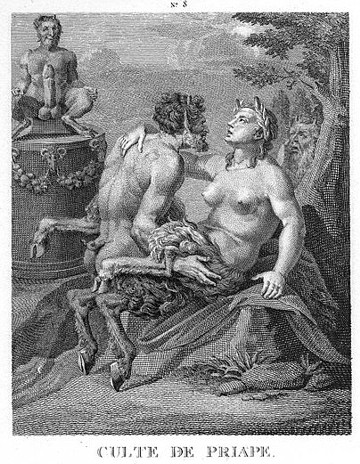
Agostino Carracci (Bologna 1557 - Parma 1602)
Dans la mythologie grecque, Priape (en grec ancien Príapos) est un dieu de la fertilité, c'est un dieu ithyphallique, protecteur des jardins et des troupeaux. Son équivalent dans la mythologie romaine se nomme en réalité Mutinus Mutunus, bien qu'il soit souvent cité sous le nom Priape. On reconnaît Priape par son gigantesque pénis constamment en érection. Cette particularité a donné son nom au terme médical priapisme.
Il naît à Lampsaque, sur l'Hellespont, en Asie Mineure. Il est le fils de Dionysos et d'Aphrodite (certaines traditions lui donnent plutôt Hermès ou Adonis, voire Zeus pour père). D'autres auteurs, le vieillissant de plusieurs générations, voient en lui un Titan auquel Héra aurait confié le soin d'enseigner le maniement des armes à Arès. Il est généralement représenté de façon grotesque, pourvu d'un énorme phallus en érection perpétuelle. Les Romains placent souvent dans leur jardin des statues grossières en bois (des hermai) de figuier, peintes de vermillon, représentant Priape, pour servir d'épouvantail.
Priape est l'obscénité incarnée. Cette difformité serait due à la malveillance d'Héra, jalouse de la beauté d'Aphrodite. Honteuse, elle abandonne l'enfant. Il est recueilli par des bergers qui apprécient sa rusticité. Priape écarte le mauvais œil et sa statue protège les vergers, mais il ne connaît ni le plaisir ni la fécondité. Il aime qu'on lui sacrifie un âne: une nuit où il allait violer Hestia, la déesse est avertie par un braiment. Pour la fête d'Hestia, en revanche, les ânes sont couronnés de fleurs. Une explication différente est donnée de sa haine pour les ânes: elle a pour origine une querelle avec un âne que Dionysos a doté de la parole, en récompense d'un service. La cause en est la taille respective de leur membre viril. Priape a le dessus et bat l'âne à mort.
Bien qu'à l'origine, les peuples gaulois étaient tournés vers le culte de la déesse, comme Belisama par exemple, ils avaient aussi dans leurs panthéons des dieux masculins. Après la conquête de la Gaule, et sous l'influence grandissante des Romains, le culte du phallus, et donc de Priape, entra dans la sphère gauloise. Un culte particulier gallo-romain se développa alors autour du phallus. En pathologie, le priapisme désigne une érection douloureuse et prolongée et ceci sans provocation érotique.
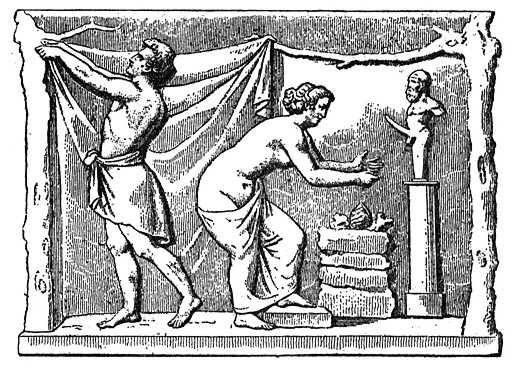
Priapisme

Le priapisme est une situation pénible et potentiellement dangereuse dans laquelle le pénis après l'érection ne retrouve pas sa flaccidité normale au bout de quatre heures, même en l'absence de toute stimulation physique ou psychologique. Le priapisme est une urgence médicale et a besoin d'être traité par un médecin qualifié. La contrepartie féminine de cet état est connue sous le nom de clitorisme.
Les mécanismes du priapisme sont mal compris, mais ils impliquent des facteurs neurologiques et vasculaires complexes. Il peut être associé à une activité sexuelle prolongée, à la leucémie, à la maladie de Fabry, à des désordres hématologiques (comme la drépanocytose), à une maladie cérébro-spinale (comme la syphilis), à une infection génitale, à certaines blessures de la colonne vertébrale, ou à une inflammation (Beers & Berkow, 1999). Le priapisme peut être provoqué par des médicaments comme certains antidépresseurs, des antihypertenseurs, des anticoagulants et des corticostéroïdes. Il peut aussi être un symptôme de privation de drogues comme l'héroïne. Le priapisme accompagne souvent les blessures de la colonne vertébrale ou les traumatismes de la moelle épinière. C'est en partie parce qu'une grande partie des signaux transmis par la moelle épinière aux organes sexuels sont inhibiteurs: dès qu'ils disparaissent le pénis est désinhibé et entre en érection.
Une des classes de médicaments les plus efficaces pour provoquer un priapisme et lutter contre la dysfonction érectile est constituée par les inhibiteurs de type 5 (PDE5) aux phosphodiestérases comme le sildénafil (plus connu sous le nom de Viagra), le tadalafil et le vardénafil. L'injection d'alprostadil est aussi efficace pour provoquer un priapisme et lutter contre la dysfonction érectile. L'antidépresseur / sédatif trazodone a été associé lui aussi au priapisme.
Lorsque les mantes religieuses copulent, le fait que la femelle mange la tête du mâle provoque une désinhibition de l'instinct de saillie chez le mâle et rend la copulation plus efficace. On dit aussi qu'un pendu entre en érection et peut éjaculer. Mais ici la cause n'est pas une désinhibition du pénis, mais est due au fait que le sang afflue vers les extrémités inférieures du corps lors de la pendaison.
Les complications potentielles incluent l'ischémie, la coagulation du sang retenu dans le pénis (thrombose) et l'endommagement des vaisseaux sanguins du pénis qui peut avoir comme conséquence une fonction érectile diminuée ou une impuissance. Dans les cas sérieux, la gangrène peut survenir et au pire rendre nécessaire la castration ou l'ablation du pénis.
Il faut immédiatement consulter un médecin si une érection se prolonge au-delà de quatre heures. Généralement, on dirige le malade vers les urgences. La thérapie à ce stade consiste à aspirer le sang du corps caverneux sous anesthésie locale. Si cela ne suffit pas, on peut pratiquer des injections de pseudoéphédrine pour y aider. Tout cela ne peut être exécuté que par un urologue expérimenté, le patient restant constamment sous contrôle hémodynamique, car la pseudoéphédrine peut provoquer hypertension et bradycardie.
Si l'aspiration échoue et que la tumescence se reproduit, on tente alors la chirurgie en essayant d'inverser l'état priapique en faisant passer le sang des corps caverneux rigides dans les corps spongieux (qui contiennent le gland et l'urètre). On commence par des shunts distaux, suivis de shunts proximaux.
Dans les shunts distaux, comme les shunts de Winter, il faut percer le gland (la partie distale du pénis) dans un des corps caverneux, où le sang stagnant est retenu. Ainsi le sang quitte le pénis et la circulation recommence. Cette procédure peut être exécutée par un urologue au chevet du malade.
Dans les shunts proximaux, comme les shunts de Quackel, c'est plus compliqué car il faut ouvrir le périnée là où les corps caverneux rencontrent les corps spongieux, faire une incision aux deux et suturer les deux ouvertures.
Le nom vient de dieu Priape, et fait allusion à son attribut le plus remarquable: une version intéressante de ce mythe de Priape veut qu'il ait été puni par les dieux pour avoir essayé de violer une déesse; on lui donna en punition d'énormes attributs de bois, ensemble énorme mais inutile.




